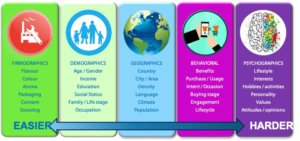Businesses often make the mistake of trying to sell to everyone, rather than running a segmentation. Are you guilty of this?
Why is this a mistake? Well, if you try to please everyone you end up delighting no one. This is why best-in-class marketers work with best-practice segmentations. And targeting the biggest group is not often the best strategy. In fact, it rarely is. Read on to find out why.
Your brand needs to appeal to a group of customers who are looking for the solution you are offering. This means that you need to make a choice of who to target amongst all category users. Making a choice implies that you will have to ignore some category users who you could perhaps attract. This seems counter-intuitive and makes many marketers scared. Does it scare you not to try and go after everyone?
It certainly worries many marketers and yet it’s the only way to sell more. Although this may not sound like common sense at first, segmentation actually ensures that you have the best possible chance to satisfy the needs of your targeted customers. Once you are satisfied with your results, you can always go after secondary target groups.
But let’s start at the beginning with the essentials of segmentation.
Where to Start: Targeting
When deciding who to target, most companies conduct some sort of analysis. This can be as simple as identifying your users by what you observe, such as young men, older housewives, or mothers of large families. And although these are easy to articulate, you are working with demographics, something every other brand can do as well. It also has the weakness of not truly understanding why your customers are choosing your brand – or not – over the competition.
It therefore makes much more sense, to move on to a more sophisticated segmentation, just as soon as you can. Why? Because it is far more powerful. For example, rather than appealing to “young men”, targeting “those who value freedom and are looking for brands that can provide or suggest this dream” will immediately provide a clearer image of the group. Even if the majority of the segment are young men, the description is far more actionable. Do you see why?
Providing a detailed description of your target customers will always have the advantage of making engaging them that mush easier, because you will be speaking “their language.”
Types of Segmentation
I mentioned above that you can simply use demographics to segment all category users. But I also alluded to the fact that it is not very distinctive, or competitive. The sooner you can run a more complex segmentation the better.
The first thing to know about the essentials of segmentation is that there are five main types:

Firmagraphics: This is the most basic and is usually how the industry separates the different types of products and services. For example alcoholic versus non-alcoholic beverages, or still and sparkling, or bottles versus cans.



